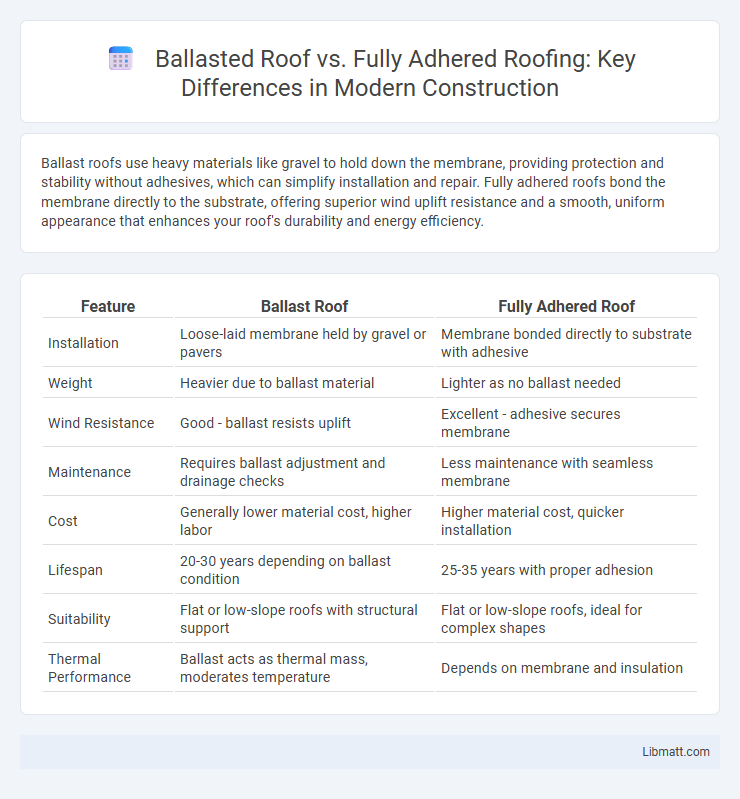Ballast roofs use heavy materials like gravel to hold down the membrane, providing protection and stability without adhesives, which can simplify installation and repair. Fully adhered roofs bond the membrane directly to the substrate, offering superior wind uplift resistance and a smooth, uniform appearance that enhances your roof's durability and energy efficiency.
Table of Comparison
| Feature | Ballast Roof | Fully Adhered Roof |
|---|---|---|
| Installation | Loose-laid membrane held by gravel or pavers | Membrane bonded directly to substrate with adhesive |
| Weight | Heavier due to ballast material | Lighter as no ballast needed |
| Wind Resistance | Good - ballast resists uplift | Excellent - adhesive secures membrane |
| Maintenance | Requires ballast adjustment and drainage checks | Less maintenance with seamless membrane |
| Cost | Generally lower material cost, higher labor | Higher material cost, quicker installation |
| Lifespan | 20-30 years depending on ballast condition | 25-35 years with proper adhesion |
| Suitability | Flat or low-slope roofs with structural support | Flat or low-slope roofs, ideal for complex shapes |
| Thermal Performance | Ballast acts as thermal mass, moderates temperature | Depends on membrane and insulation |
Introduction to Ballast Roof and Fully Adhered Systems
Ballast roof systems use heavy materials like gravel or pavers to secure the roofing membrane, providing stability and protection against wind uplift. Fully adhered roofing involves bonding the membrane directly to the substrate with adhesive, ensuring a sleek, durable, and waterproof seal. Both systems offer unique benefits for commercial flat roofs, with ballast roofs favored for ease of installation and fully adhered roofs preferred for high performance and minimal maintenance.
Key Differences Between Ballast and Fully Adhered Roofing
Ballast roofing uses heavy materials like gravel or pavers to secure roofing membranes, providing protection against wind uplift while allowing easy access for maintenance. Fully adhered roofing systems bond membranes directly to the substrate with adhesives, creating a seamless barrier that enhances durability and reduces the risk of leaks. Key differences include installation methods, with ballast relying on weight for stability and fully adhered systems relying on adhesive strength, impacting factors like cost, lifespan, and suitability for different building types.
Components and Installation Process of Ballast Roofs
Ballast roofs consist of a waterproof membrane covered by loose stone or pavers that hold the system in place, providing protection from UV rays and wind uplift. The installation process involves securing the membrane to the roof deck, then evenly distributing ballast material without penetrating the membrane, ensuring enhanced durability and stability. Your roof benefits from easier maintenance and improved drainage due to the ballast's weight and spacing properties.
Components and Installation Process of Fully Adhered Roofs
Fully adhered roofs consist of a single-ply membrane that is glued directly to the insulation or substrate using adhesives, creating a continuous, seamless barrier against water intrusion. Key components include the membrane itself, adhesive, insulation boards, and a vapor retarder, which together ensure durability, energy efficiency, and moisture control. The installation process involves cleaning the roof deck, applying adhesive uniformly, rolling the membrane into place, and using pressure rollers to remove air bubbles for a strong bond and long-lasting performance.
Advantages of Ballast Roof Systems
Ballast roof systems offer significant advantages such as enhanced protection against UV radiation and mechanical damage, extending the lifespan of your roof membrane. The loose gravel or stones provide excellent ballast, resisting wind uplift and simplifying installation without needing adhesives or fasteners. These systems also improve drainage and thermal performance by regulating temperature fluctuations and shielding the roof deck from direct sun exposure.
Benefits of Fully Adhered Roof Systems
Fully adhered roof systems provide superior wind uplift resistance and enhanced waterproofing compared to ballast roofs, reducing the risk of leaks and structural damage. These systems create a seamless membrane that improves energy efficiency by minimizing air and moisture infiltration. Your building benefits from easier maintenance and inspections due to the smooth, uniform surface of fully adhered roofs.
Common Challenges and Limitations of Ballast Roofs
Ballast roofs often face challenges such as ballast displacement during high winds, which can expose the underlying membrane and reduce protection. The added weight can impose structural stress on buildings not designed to accommodate heavy loads, limiting their use on certain structures. Additionally, maintenance difficulties arise due to the need to remove ballast layers for inspections or repairs, increasing labor time and costs.
Common Drawbacks and Issues With Fully Adhered Roofs
Fully adhered roofs often face issues such as membrane punctures caused by foot traffic or sharp objects, leading to potential leaks and costly repairs. These systems may also experience difficulty with adhesion in extreme weather conditions, resulting in blisters or bubbles that compromise roof integrity. Additionally, fully adhered roofs typically require longer installation times and precise application techniques, increasing labor costs and the risk of installation errors.
Cost Comparison: Ballast Roof vs. Fully Adhered
Ballast roofs typically offer lower upfront material and installation costs compared to fully adhered roofing systems due to simpler application methods and less specialized labor. Fully adhered roofs, while more expensive initially, provide superior waterproofing and wind uplift resistance, potentially reducing long-term maintenance and repair expenses. Evaluating total lifecycle costs reveals that ballast roofs may be more budget-friendly short-term, whereas fully adhered systems deliver greater durability and cost-efficiency over time.
Best Applications and Recommendations
Ballast roof systems are best suited for large commercial buildings with flat or low-slope roofs where weight distribution and easy roof access for maintenance are priorities. Fully adhered roofing membranes excel on structures requiring strong wind uplift resistance and enhanced waterproofing, making them ideal for high-rise buildings or roofs with complex shapes. For long-term durability and minimal ballast maintenance, fully adhered roofs are recommended, while ballast roofs offer cost-effective installation and environmental benefits through the use of natural stone or pavers.
Ballast roof vs fully adhered Infographic

 libmatt.com
libmatt.com